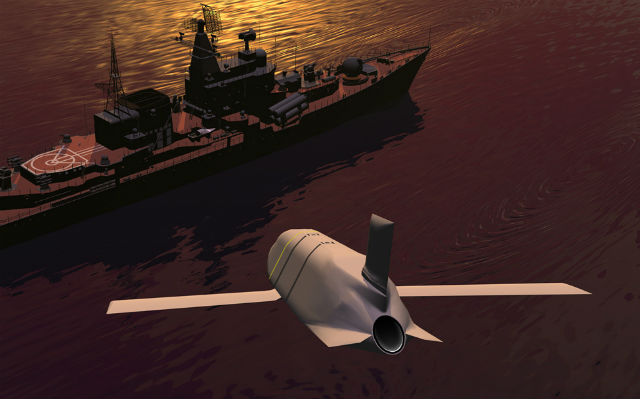Lockheed Martin says it recently completed a series of captive carry flight tests for a new long-range anti-ship missile (LRASM) it is developing for the US Defense Advanced Research Projects Agency (DARPA) and the Office of Naval Research (ONR) over the Point Mugu sea range off the California coast.
The new weapon, based on Lockheed's AGM-158B Joint Air-to-Surface Stand-off Missile-Extended Range (JASSM-ER), is expected to make its first free flight test this year.
Mike Fleming, Lockheed LRASM air launch programme manager, says the captive carry tests were flown on board a Boeing B-1B, because the JASSM-ER is already integrated with the US Air Force's strategic bomber.
"Collecting telemetry data while flying in the B-1B bomb bay significantly reduces risk ahead of the first launch," Fleming says. "Initial assessments indicate the missile performed as expected."
The LRASM is slightly modified from the original JASSM-ER to incorporate a multimode "radio frequency" sensor, but Fleming cannot say more than that about the DARPA-furnished hardware.
The LRASM also incorporates a new weapon datalink, an altimeter and an uprated power system. However, it is largely the same weapon system as the JASSM-ER, with no other changes to the airframe or outer mould line.
 |
|---|
Lockheed Martin |
For the anti-ship role, the weapon can either be cued by the launch platform or receive updates via its datalink. But, Fleming says, even if the weapon is only given a general area in which to find its quarry, its onboard sensors will be able to locate and attack an enemy warship.
To defeat the increasingly sophisticated air defences of modern warships, the LRASM will fly towards its target at medium altitude, before dropping down to low altitude to act as a sea-skimming stealth cruise missile during the terminal phase of the engagement, Fleming says. The JASSM-ER has a range of more than 500nm (925km), but publicly DARPA will only say the LRASM has a range greater than 200nm.
This year, DARPA and the ONR will conduct test flights of instrumented versions of the new weapon from the B-1. In 2014, the programme will also conduct vertical launches from the Mk 41 vertical launch system found on US Navy warships such as Arleigh Burke-class guided-missile destroyers and Ticonderoga-class guided-missile cruisers, from a so-called "desert ship" at the White Sands missile range in New Mexico.
For the surface launch capability, Fleming says the weapon is slightly modified to incorporate a jettisonable Mk 114 rocket booster on the tail-end of the missile. Once the rocket boosts the weapon up to medium altitude, the surface-launched LRASM will operate like an air-launched version.
Lockheed has also explored concepts for a submarine-launched variant of the LRASM, Fleming says, but the first priority is the air-launched weapon, followed by the surface-launched variant. The company was selected by DARPA to demonstrate the LRASM's air- and surface-launched capabilities following a competition in 2009.
Fleming says the current contract with DARPA is for maturing the LRASM technology, but he believes there will be a follow-on contract for further development. However, the navy has yet to formalise what it wants from a follow-on anti-ship missile.
Source: Flight International























